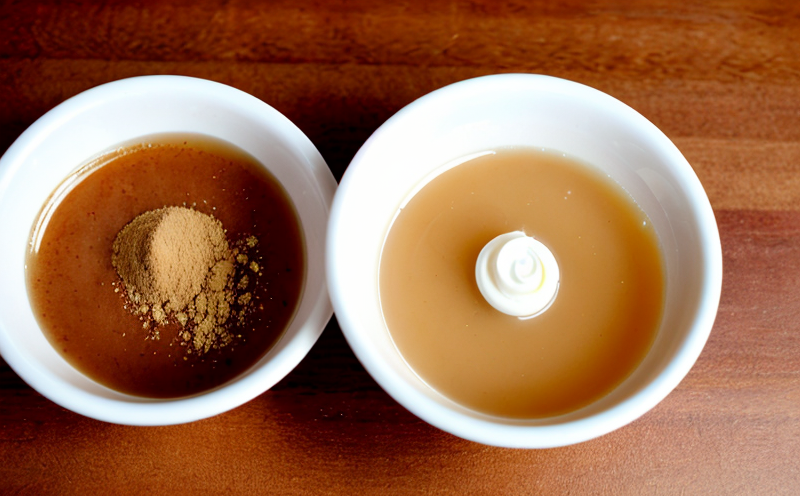AOAC 99714 Flavor Residue Testing in Fruit Juices
The AOAC International method 997.14 is a critical tool used by laboratories to ensure the quality, safety, and compliance of fruit juices with respect to flavor residue levels. This method provides a standardized approach for quantifying the residual flavors that remain after processing, which can affect product stability and shelf life.
Flavor residues in fruit juices are often introduced during manufacturing processes such as pasteurization or concentration. These residues can lead to off-flavors or aromas if not managed properly. By using AOAC 99714, laboratories ensure that the flavor profiles of these products meet industry standards and consumer expectations.
The test method involves extracting residual flavors from fruit juice samples using a solvent followed by analysis via chromatography techniques such as gas chromatography-mass spectrometry (GC-MS). This allows for precise quantification of individual compounds, enabling manufacturers to understand the exact nature and concentration of flavor residues in their products.
One key aspect of this testing is understanding the baseline levels of natural flavors present in raw materials versus those introduced during processing. This helps identify any unintended additions that could impact product quality or require further scrutiny for regulatory compliance.
Another important factor is ensuring consistency across batches and geographical regions where different raw materials may be sourced or processed differently. AOAC 99714 provides a consistent methodology, allowing companies to maintain uniformity in their products regardless of location or supplier.
The importance of this testing extends beyond just flavor profiling; it also plays a crucial role in maintaining product integrity and consumer trust. Regulatory bodies like the Food and Drug Administration (FDA) and European Commission set guidelines for acceptable levels of flavor additives, and AOAC 99714 ensures that these limits are adhered to.
By leveraging this method, manufacturers can avoid potential recalls due to unacceptable flavor profiles or legal issues stemming from non-compliance with regulatory requirements. Additionally, it allows them to continuously improve their processes by identifying areas where adjustments might enhance product quality without compromising safety.
In summary, AOAC 99714 is an essential tool for ensuring the highest standards of flavor control in fruit juices, supporting both compliance and innovation within the industry.
Applied Standards
| Standard | Description |
|---|---|
| AOAC International Method 997.14 | This method outlines the procedure for determining flavor residues in fruit juices by extracting residual flavors using a solvent followed by analysis via gas chromatography-mass spectrometry (GC-MS). |
| ISO/IEC Guide 30:2007 | Guidance on conformity assessment, which includes the application of methods like AOAC 99714 to ensure consistency and reliability in analytical results. |
The AOAC International Method 997.14 is widely recognized for its accuracy and reproducibility, making it a preferred choice among laboratories worldwide. Compliance with this standard not only ensures that the testing process meets international quality assurance criteria but also facilitates easier traceability of results across different jurisdictions.
Industry Applications
| Application | Description |
|---|---|
| Fruit Juice Manufacturing | This method is particularly useful for monitoring the quality of flavor residues in fruit juices throughout production, helping manufacturers maintain consistent product quality. |
| Regulatory Compliance | By adhering to AOAC 99714, companies can ensure their products meet regulatory requirements set by bodies such as the FDA and EC. |
| R&D Innovation | The ability to precisely quantify flavor residues allows researchers to innovate new formulations while maintaining product integrity. |
AOAC 99714 finds extensive application in various sectors of the food and beverage industry, particularly those dealing with fruit juices. It supports continuous quality improvement initiatives by providing detailed insights into flavor profiles, enabling companies to make informed decisions that balance taste preferences with regulatory expectations.
Customer Impact and Satisfaction
Implementing AOAC 99714 flavor residue testing in fruit juices offers several benefits that ultimately contribute to customer satisfaction:
- Enhanced Product Quality: Consistent measurement of flavor residues ensures that each batch meets the desired taste profile, leading to higher-quality products.
- Regulatory Compliance: By adhering to international standards, companies avoid legal issues associated with non-compliance and can confidently market their products globally.
- Innovation Support: Precise quantification of flavor residues facilitates the development of new formulations that meet both consumer expectations and regulatory requirements.
- Consistent Customer Experience: Maintaining uniformity in product quality across different regions improves customer loyalty and satisfaction.
- Cost Efficiency: Early detection of potential issues through testing prevents costly rework or recalls later on.
- Environmental Responsibility: Proper management of flavor residues reduces waste and supports sustainable practices within the industry.
These factors collectively enhance customer trust, satisfaction, and loyalty, contributing to long-term success in the fruit juice market.





